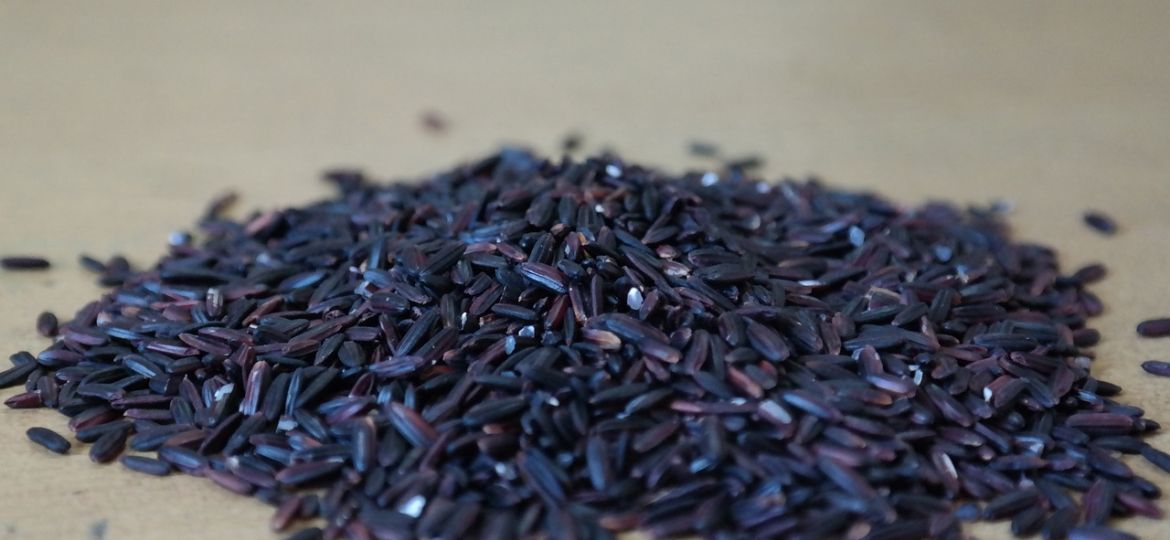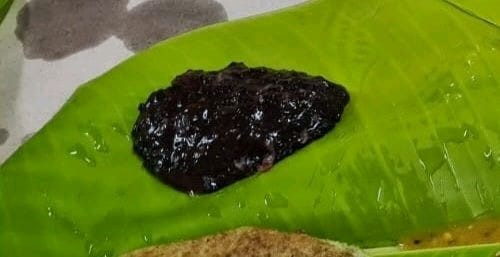
Stop everything!
I have a condition that you must follow before you read any further, before you consume what I’ve prepared in any form. Respond to the following.
Purple.
What does that mean to you?
When was the last time you saw something purple?
Do you know what it feels like? Can you describe it? Does it have any particular flavour? Nibble on these prompts, I’ll wait.
…
Stay with these thoughts, and now tuck in.
My day was purple. I am wearing it. It has followed me throughout the day. I’ve encountered it in unusual places. Under my foot as a wrapper. At home. Now, at the dining table and on my computer screen as a light-hued circle with an ‘H’ as I finger edits into my own work. Most strikingly, it found me, moist, supple, yet firm, under a banana leaf, deep as a jamun and sweet on the tongue.
I am pursued by purple. However, my essay is not about the colour purple or, as we call it in Tamil, Ūtā. Neither is it about things that are purple. Rather, it is the possibilities that it invokes — of encounters, flavours, places, textures, identity, histories, moments and memories.
In this essay, purple is not a colour, it is not a phenomenon. It is an experience. It is the absent referent to several things.
But to orient your reading, Purple means sweet.
Through the allegorical purple, let me take you elsewhere, in the past. December 2022, Karaikudi, Sivagangai district, Southern Tamil Nadu.
I was there for a wedding. Not mine — an experience my sexuality disqualifies me to have with the similar pomp and rigour as my friend’s sister did. A purple wedding invitation took me there. I had received it a few weeks prior from a treasured friend and confidante. Let’s call them Citriṉ.
I first met Citriṉ in 2017, at college. Few months into our relationship, it was understood that I would attend her sister’s wedding, the date of which, at that time, was undecided. There was much anticipation for this event. For one friend of ours, it presented an opportunity to visit Citriṉ’s fabled ancestral home. For another, it was the promise of travel. But for me, it was a sweet dish.
Citriṉ called it kavuni arisi or black rice. Later, I would learn that this rice is not only a characteristic ingredient in dishes prepared by a particular community, but it also occupies an interesting place in the Tamil imagination. An apocryphal memory suggests that black rice was considered to be so valuable that its theft would result in immediate death. It was forbidden rice and principally consumed by the nobility. Well, no longer.
Rice is a staple in the Tamil household but kavuni arisi or the ‘idea’ of black rice is oddly outlandish. Most Tamilians consume rice that is white. Some dining tables might have the occasional red and shapely rice that Keralites eat. But that too isn’t ‘red’ in the strictest sense. Kavuni arisi is undeniably black.
Yet, the halwa that Citriṉ shared with us was not black. It was purple, deep and rich purple. A shade that looks almost black until it smears your palm. You see, black rice is — I would learn later – glutinous and sticky (a cheap alternative to the ridiculously costly imported sticky rice). The alchemy of cooking transforms that which is black into a robust purple.

Photo credit: Hanish Srinivasan
My first encounter with kavuni arisi was indulgent, sweet, memorable, and left me yearning for more. Though it looked like sakarai pongal or sweet pongal, it was a deep-hued purple halwa. In terms of texture, it maintained the orthodoxy of pongal, but in terms of mouth feel, it reminded me of Thirunalveli’s ghee-soaked halwa.
This was a chance encounter. Incidental festivity at Citriṉ’s household, led her mother to prepare this dish, one her community much relishes. It was made to be shared. I’d like to believe that black rice is part of the mundane for Citriṉ but it transforms into a marker of novelty when it leaves the confines of the kitchen, out into a container, and into the world beyond.
This sweet, of which I asked for a second helping, presented Citriṉ with an opportunity to tell us about her community. The next time she would share it with me would be at a pandhal or feast, at her sister’s wedding.
The bus ride to Karaikudi took me 8 hours. To taste kavuni arisi halwa in its proud and authentic form, it took four years.
It’s interesting how, I, an outsider to a community with strict rules of membership, required a wedding for the sweet in question to grace my tongue.
What is a wedding? It is an event where marriage takes place between members of opposite sexes, if not genders. Two families come together. Relatives and well-wishers are invited. Structures are erected, garlands woven. Costly attire and shining jewellery are on display. The kitchen perspires with alchemic movement. The bride is awaited. Spaces are prepared.
There is anticipation.
The variables are constant, no matter the number of times we orchestrate them. One wedding differs from another purely based on the arrangement of these elements. We know our roles, and when the day arrives, we sport appropriate costumes, play our parts, partake in expending time and energy, occupy the wedding space, consume unmoderated amounts of food, and, of course, exchange niceties, shed a tear or two and leave.
This wedding was different. It happened at home, at Citriṉ’s home. Well, not her ancestral home, but at the community house, few streets away from her own.
When you come to Karaikudi, you will be overwhelmed by the houses. These homes are an architectural wonder and a testament to the craftsmanship of a well-known trader-caste. The Chettiars.
Kavuni arisi led me to that moment. While others, especially community members, were welcoming this union, my anticipation was focused elsewhere. I was yearning for that sweet.
This wedding was intimate. Not only was I pulled aside multiple times by elderly men to be educated on the unique customs and rituals of the Chettiars. I also became acutely aware of their pride, and hope. They wanted this wedding. They needed it.
What is a wedding? It is union. It is proof and a promise that one’s community will go on. That a wedding will lead to a family. The wedding orchestrates and creates the possibility for what follows. Consummation.
A marriage really is about procreation, and continuation of lineage, within the community. The Chettiars, a small and prominent community known for its material wealth and business acumen, and marred by mishaps of the recent past, rejoice in the pride they collectively generate through these events. Not only does marriage charter the transfer of property, it signals that the legacy of the Chettiars will continue and occupy contemporary memory in various forms.
One of those forms, is food.
While Chettinad cuisine is famous, one is unlikely to easily find canonical dishes like kavuni arisi halwa at a popular restaurant like Anjappar.
I was able to enter the pandhal or dining area after the kettimelam — the wedding drumrolls that precede the ceremonial tying of the three knots of the mangalsutra or Tāli around the neck of the bride by the groom.
The idiom “You are what you eat” came alive at the wedding pandhal. The purple invitation that Citriṉ shared with me was not just her family’s wish for me to witness a rare and ‘auspicious’ event, but it was an opportunity to literally eat (like) the Chettiar community, and for a moment, become one with them.
I’d like to think of this too as a consummation of sorts. If the disciplined union of man and woman gives reassurance to the community, what does a scene of unmoderated consumption of a community’s food offer. Pride? And if pride leads to pleasure, are we not veering towards the language of sensual experience?
A wedding is marked by anticipation. For some it is to experience their own wedding. As for me, despite my troubled relationship with the idea of marriage, I still long for the pomp of the event while knowing that I can never truly claim such an experience for myself. And so, I simply longed for sweet food.
At weddings, I lose myself. That day, like at most weddings, I overate.
One seldom plans to overeat. No one plans to indulge to the point of self-loathing.
Moderation is often a virtue preached by those scarred by gluttony.
It happens quickly. Our appetite builds, and the more food we finger into our mouths, the more food is piled on to our banana leaves. Even as we near satiety, the momentum of consumption seldom slows. It is not until the climax of that last mouthful, when we can take in no more, do we stop. My purple soiled hands were testament to this. I still remember my 5th serving of kavuni arisi halwa. I had already had my fill. But there it was, warm, sprinkled with roasted cashews, the halwa smearing its juices onto my banana leaf — inviting, warm and promising.
At the pandhal, there is only impulse.
It is interesting to note how it is women, Chettiar women, who led me to this moment.
If we wind back to moment when I first encountered kavuni arisi halwa, we note the involvement of Citriṉ, her mother, and the promise of her sister’s eventual involvement.
They were the necessary ingredients for me to taste the identity of a community, its hope and sentiments.
But, for some reason, the sweet I lost myself in was not made by these women. Neither was it made by any woman. I was served by women, but binding history, method, technique and pride to this dish, was an elderly man, a chef. He, like his father, and his father before him, was the inheritor of the ways of a community, a framework of being.
I will never know what it is like to be a Chettiar because that is not something that can be encapsulated and communicated in any form. It was necessary for the wedding to occur for me to reunite with kavuni arisi halwa. A dish is not the product of mere creative impulse. The ingredients used, the method of preparation, the knowledge and technique required to manipulate black glutinous rice into submission, so as to bear the mark of the Chettiars, is not something that happens by chance.
When I slipped that dessert into my salivating mouth, I was not digesting mere starch, sugar and oils. I was consuming history, identity, knowledge, memory, and time, all encapsulated in a single mouthful.
When we look at food, like I did with purple, as something which is not merely consumed, but as a wormhole to sensorial reproduction, we can arrive at the conclusion that within each helping is a possibility of reorganising reality itself.
Kavuni arisi altered my knowledge, teased my desire, and seared in me a longing for more.
Cover Image: Image by Cecep Risnandar from Pixabay